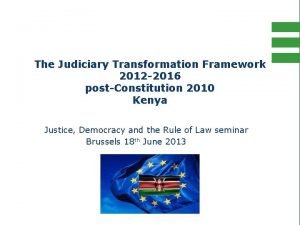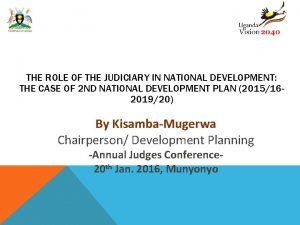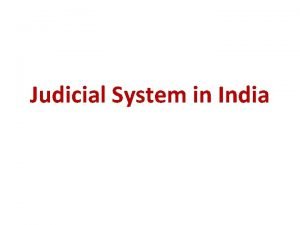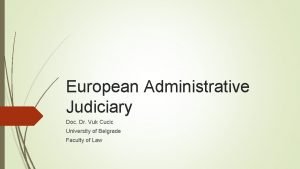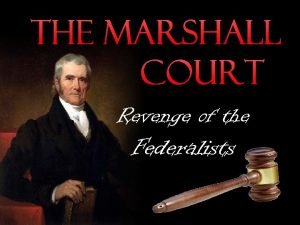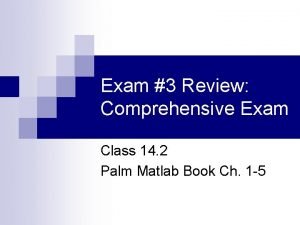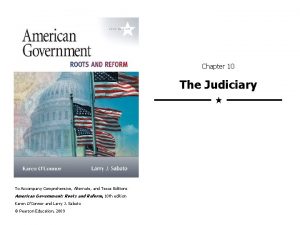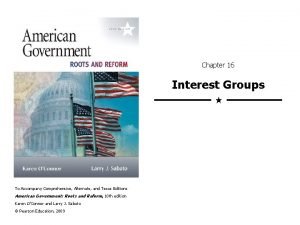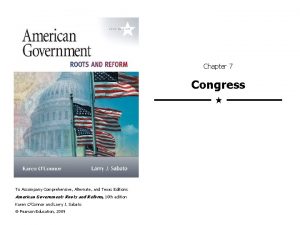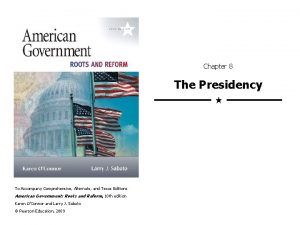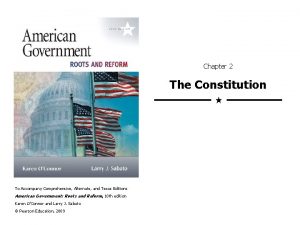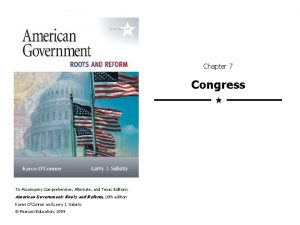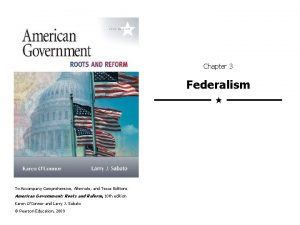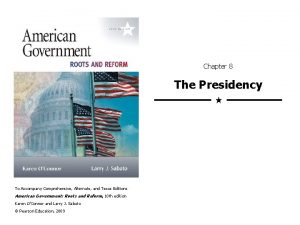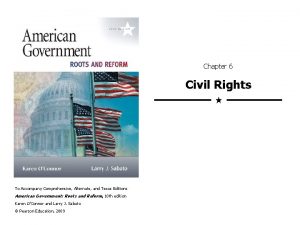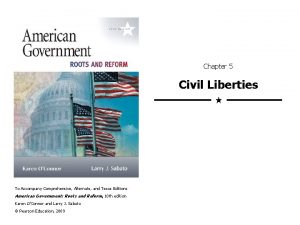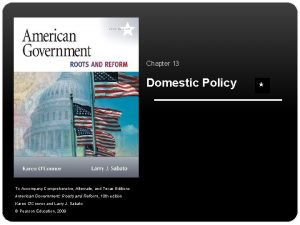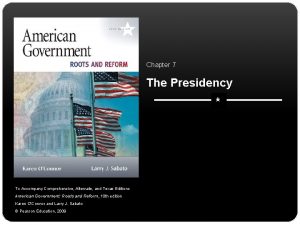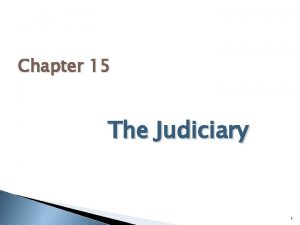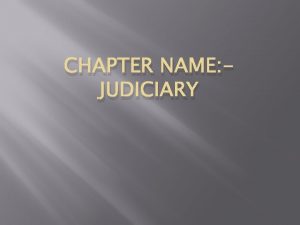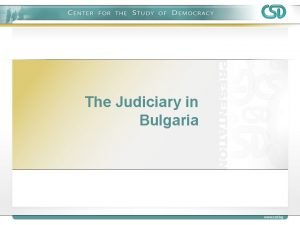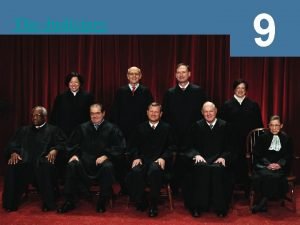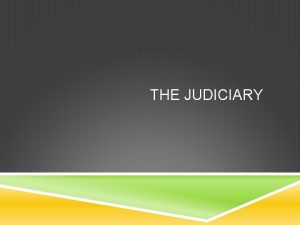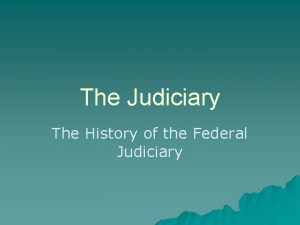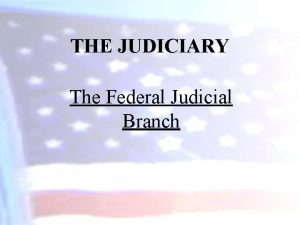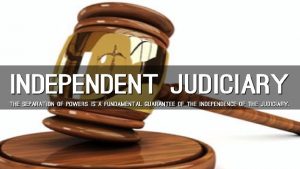Chapter 10 The Judiciary To Accompany Comprehensive Alternate































- Slides: 31

Chapter 10 The Judiciary To Accompany Comprehensive, Alternate, and Texas Editions American Government: Roots and Reform, 10 th edition Karen O’Connor and Larry J. Sabato Pearson Education, 2009

Roots of the Federal Judiciary Hamilton called it “the least dangerous branch. ” Little on the judiciary in the constitution. Creates high Court, Congress establishes others. Judges have life tenure with good behavior. Congress can alter the Court’s jurisdiction. Constitution is silent on judicial review.

Judiciary Act of 1789 Established three-tiered federal court system. Can appeal through the system. Federal district courts at the bottom. Courts of appeals in the middle. U. S. Supreme Court at the top. Court had little power, few wanted to serve.

The Marshall Court Chief Justice John Marshall gave Court prestige. Discontinued practice of seriatim. Established power over states in Mc. Culloch (1819). Established judicial review in Marbury v. Madison (1803).

American Legal System A court must have jurisdiction to hear a case. Jurisdiction can be original or appellate. Cases can be criminal or civil. Most courts are constitutional courts. Specialized legislative courts may also be created.

Dual Legal System Three Tiered Federal Sys Three Tiered State Sys • Trial Courts • Appellate Courts • High or Supreme Court – 94 District Courts – Original Jurisdiction • Appellate Courts – 11 Circuit Courts – D. C. Court of Appeals – U. S. Court of Appeals for the Federal Circuit • Supreme Court – Original and Appellate Jurisdiction

Stare decisis “let the decision stand” • Decisions made by Courts of Appeal are binding upon the district courts • Decisions based on past decisions of the Courts of Appeal (precedents) • Leads to Continuity and predictability in the legal system

District Courts Trial courts of original jurisdiction. At least one per state. Cases involve federal government or question. Also citizens from two states if over $75, 000. Cases decided by a single judge (possibly with jury).

Courts of Appeals Appellate courts with no original jurisdiction. Cases decided by three-judge panels. Cases are appeals from district courts or agencies. Correct errors of procedure or law. Submit a brief to have a case heard. Decisions set a precedent for only that circuit. Judges may abide by stare decisis. (must be considered)

Supreme Court Appellate and original jurisdiction. Ensures uniform interpretation of laws. Maintains national supremacy. Nine justices hear decisions en banc.

Selecting Federal Judges President makes appointments. Use of senatorial courtesy. (District Court Judges) Filibustering – Nuclear Option – Gang of Fourteen – Clinton and Bush appointees Bush 100+ recess appointments Competence; use of ABA ratings. Ideology or policy preferences. Rewards or political support. Religion, race, ethnicity, and gender.

Supreme Court Confirmation List of potential nominees sent to FBI and ABA. Candidates investigated and rated. Well Qualified, Not Qualified G. W. Bush informed ABA they would no longer receive names of nominees. ABA still rated after names were released to public Interest groups mobilize lobbying efforts. Senate holds committee hearings. Senate Judiciary Committee Full Senate votes on nominee.

Deciding to Hear a Case Works hard for privacy and decorum. Receives many more cases than it can hear. 9, 600 filed, 90 argued, 88 signed opinions in 2005 -2006 Interested parties file a writ of certiorari. Court decides to hear case using Rule of Four. Clerks play key role throughout process.

Factors Influencing Review Solicitor general asking for review. Solicitor general files amicus brief, as well as interest groups (70 -80% appeals of the U. S. government) The more amicus briefs filed the more likely to be heard Conflict among the courts of appeals. Case presents civil rights or liberties question. Half of all cases deal with the Bill of Rights Case involves policy preferences of the justices. Significant political or social interest

Hearing and Deciding the Case Amicus briefs may be submitted beforehand. Oral arguments generally last one hour. Open to the public Solicitor general may also appear. Oral argument provides chance to ask questions. Meet in closed conference to discuss and vote. Opinion written and circulated but not before much consideration and rethinking Concurring or dissenting opinions may also be filed.

Judicial Decision Making Judicial activism versus judicial restraint. Judicial restraint – minimalist roles – strict construction Judicial activists – promote justice, equality, and personal liberty – loose construction Behavioral, attitudinal, and strategic models. Role of public opinion.

Judicial Policy Making All judges make policy. Court can declare laws unconstitutional. Court can overrule itself. Judicial implementation can be a challenge.

AV- Who Is Appointed? Back

Figure 10. 1 - American Court System Back

Figure 10. 2 - Federal Court System Back

Figure 10. 3 - Supreme Court Caseload Back

Figure 10. 4 - Supreme Court Process Back

Table 10. 1 - Supreme Court Jurisdiction Back

Table 10. 2 - Presidential Impact Back

Table 10. 3 - District Court Appointees Back

Table 10. 4 - The Supreme Court Back

Table 10. 5 - Interest Group Participation Back

Table 10. 6 - Supreme Court Knowledge Back

Table 10. 7 - What Do Clerks Do? Back

Table 10. 8 - Amicus Curiae Briefs Back

Table 10. 9 - Role of Public Opinion Back
 Accompany chapter 1
Accompany chapter 1 Hebrews 6 9
Hebrews 6 9 Upper limb venous drainage
Upper limb venous drainage Inkjet printers are considered legacy technology
Inkjet printers are considered legacy technology Judicial transformation framework
Judicial transformation framework Judicial activism examples
Judicial activism examples Safe public and fair judiciary
Safe public and fair judiciary Department of judiciary
Department of judiciary Judiciary system in india
Judiciary system in india Judiciary
Judiciary Whats the judiciary act
Whats the judiciary act Chapter 3 comprehensive exam
Chapter 3 comprehensive exam Hình ảnh bộ gõ cơ thể búng tay
Hình ảnh bộ gõ cơ thể búng tay Slidetodoc
Slidetodoc Bổ thể
Bổ thể Tỉ lệ cơ thể trẻ em
Tỉ lệ cơ thể trẻ em Chó sói
Chó sói Thang điểm glasgow
Thang điểm glasgow Bài hát chúa yêu trần thế alleluia
Bài hát chúa yêu trần thế alleluia Các môn thể thao bắt đầu bằng tiếng nhảy
Các môn thể thao bắt đầu bằng tiếng nhảy Thế nào là hệ số cao nhất
Thế nào là hệ số cao nhất Các châu lục và đại dương trên thế giới
Các châu lục và đại dương trên thế giới Cong thức tính động năng
Cong thức tính động năng Trời xanh đây là của chúng ta thể thơ
Trời xanh đây là của chúng ta thể thơ Mật thư anh em như thể tay chân
Mật thư anh em như thể tay chân 101012 bằng
101012 bằng Phản ứng thế ankan
Phản ứng thế ankan Các châu lục và đại dương trên thế giới
Các châu lục và đại dương trên thế giới Thơ thất ngôn tứ tuyệt đường luật
Thơ thất ngôn tứ tuyệt đường luật Quá trình desamine hóa có thể tạo ra
Quá trình desamine hóa có thể tạo ra Một số thể thơ truyền thống
Một số thể thơ truyền thống Cái miệng nó xinh thế
Cái miệng nó xinh thế




